The AMD Ryzen Threadripper 3960X and 3970X Review: 24 and 32 Cores on 7nm
by Dr. Ian Cutress, Andrei Frumusanu & Gavin Bonshor on November 25, 2019 9:05 AM ESTCPU Performance: Encoding Tests
With the rise of streaming, vlogs, and video content as a whole, encoding and transcoding tests are becoming ever more important. Not only are more home users and gamers needing to convert video files into something more manageable, for streaming or archival purposes, but the servers that manage the output also manage around data and log files with compression and decompression. Our encoding tasks are focused around these important scenarios, with input from the community for the best implementation of real-world testing.
All of our benchmark results can also be found in our benchmark engine, Bench.
Handbrake 1.1.0: Streaming and Archival Video Transcoding
A popular open source tool, Handbrake is the anything-to-anything video conversion software that a number of people use as a reference point. The danger is always on version numbers and optimization, for example the latest versions of the software can take advantage of AVX-512 and OpenCL to accelerate certain types of transcoding and algorithms. The version we use here is a pure CPU play, with common transcoding variations.
We have split Handbrake up into several tests, using a Logitech C920 1080p60 native webcam recording (essentially a streamer recording), and convert them into two types of streaming formats and one for archival. The output settings used are:
- 720p60 at 6000 kbps constant bit rate, fast setting, high profile
- 1080p60 at 3500 kbps constant bit rate, faster setting, main profile
- 1080p60 HEVC at 3500 kbps variable bit rate, fast setting, main profile
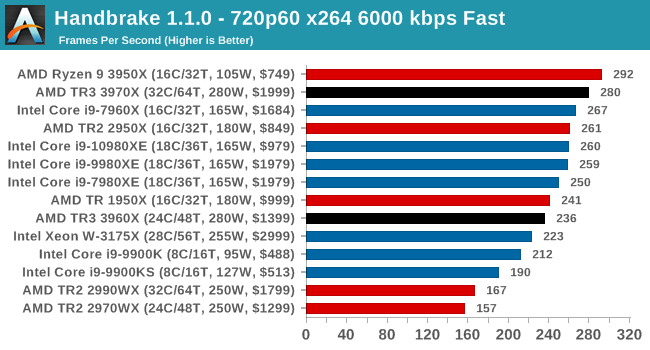
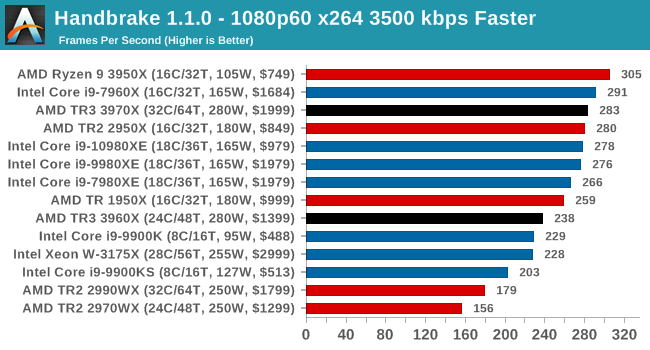

Video encoding is a little varied, based on the variable threaded nature. Certain encoding tests can be more memory sensitive here, or accelerated in different ways, or not scale well with more cores. Either way, TR3 performs a lot better than TR2, but the 3950X seems the best choice.
7-zip v1805: Popular Open-Source Encoding Engine
Out of our compression/decompression tool tests, 7-zip is the most requested and comes with a built-in benchmark. For our test suite, we’ve pulled the latest version of the software and we run the benchmark from the command line, reporting the compression, decompression, and a combined score.
It is noted in this benchmark that the latest multi-die processors have very bi-modal performance between compression and decompression, performing well in one and badly in the other. There are also discussions around how the Windows Scheduler is implementing every thread. As we get more results, it will be interesting to see how this plays out.
Please note, if you plan to share out the Compression graph, please include the Decompression one. Otherwise you’re only presenting half a picture.
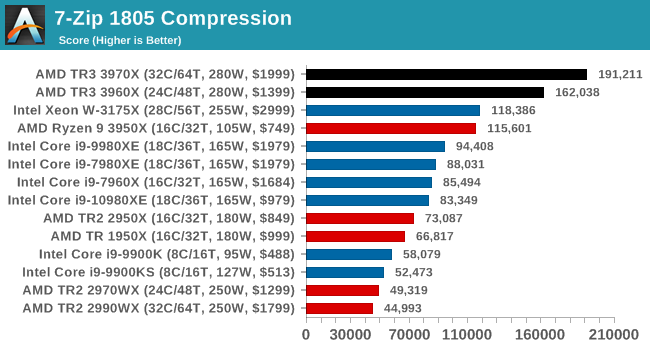
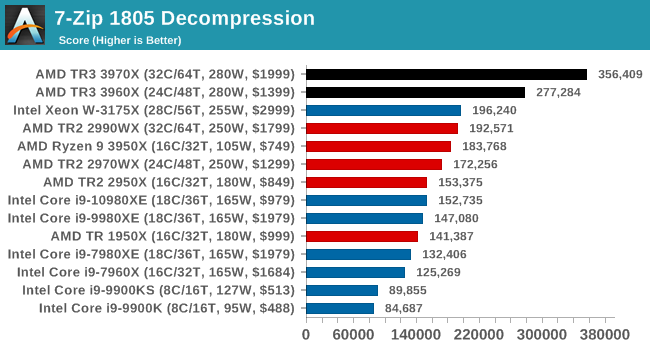
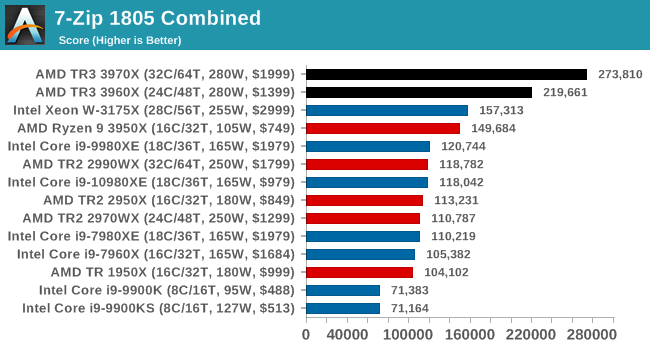
Easily parallel puts the TR3 well ahead of TR2 and Intel.
WinRAR 5.60b3: Archiving Tool
My compression tool of choice is often WinRAR, having been one of the first tools a number of my generation used over two decades ago. The interface has not changed much, although the integration with Windows right click commands is always a plus. It has no in-built test, so we run a compression over a set directory containing over thirty 60-second video files and 2000 small web-based files at a normal compression rate.
WinRAR is variable threaded but also susceptible to caching, so in our test we run it 10 times and take the average of the last five, leaving the test purely for raw CPU compute performance.
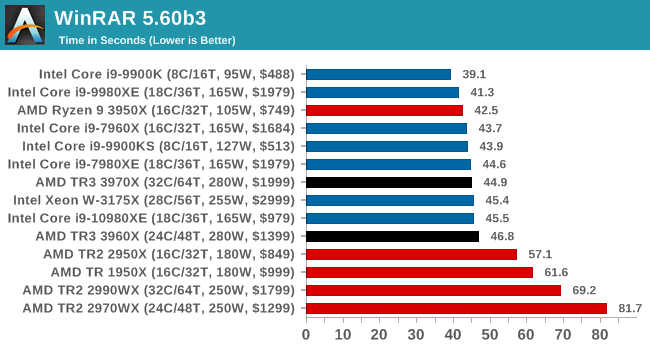
WinRAR is a variably threaded application, and both TR3 processors perform in the same ballpark as anything from Intel. Ideally we should have seen them streak ahead, but we seem to be at a point where CPU frequency or core counts are the limiting factor. At least with Zen 2, there are no issues as there was with Zen 1/Zen+.
AES Encryption: File Security
A number of platforms, particularly mobile devices, are now offering encryption by default with file systems in order to protect the contents. Windows based devices have these options as well, often applied by BitLocker or third-party software. In our AES encryption test, we used the discontinued TrueCrypt for its built-in benchmark, which tests several encryption algorithms directly in memory.
The data we take for this test is the combined AES encrypt/decrypt performance, measured in gigabytes per second. The software does use AES commands for processors that offer hardware selection, however not AVX-512.











245 Comments
View All Comments
Irata - Monday, November 25, 2019 - link
Just checked Newegg and TR3 is listed at MSRP, whereas Core i9-10980XE is listed @ $ 1,049.99.That gives it the same per-core price as TR TR 3960X.
Note: All are "out of stock", so this is purely academic.
jordanclock - Monday, November 25, 2019 - link
It's only too expensive if your time isn't worth much. These are HEDT workstation CPUs, so the ROI for saving time is much different. Even being twice as a expensive but "only" 20-50% faster can be hugely valuable for many professional tasks.Teckk - Monday, November 25, 2019 - link
Ok I'm definitely not the target for this product. Interesting to see Intel reduce the price by half and still unable to match this.FunBunny2 - Monday, November 25, 2019 - link
"Even being twice as a expensive but "only" 20-50% faster can be hugely valuable for many professional tasks."being able to run 1-2-3 only on X86/DOS made both Intel and M$ a ton of money: i.e. the Killer App. not clear that there are enough 'professional tasks' to keep either Intel or AMD, much less both, profitable. with the killer amortization of capital expense in production of chips these days, the only avenue to profit is moving ever more units. HEDT, etc. ain't it.
eek2121 - Monday, November 25, 2019 - link
3D animators save quite a bit of time over lower core count parts. Go take a look at the blender results at Gamer's nexus. Note that it takes several minutes to render 1 frame. If you are rendering thousands of frames, the speed advantage of the 3970X over *every* other chip will pay for itself pretty quick.3D animation, video encoding, compiling large projects, etc. are all areas where Threadripper trounces anything Intel.
Ratman6161 - Monday, November 25, 2019 - link
This is the reason for the statement that buyers of the Intel CPUs in this segment usually go for the top of the line. I'm not the target audience for this sort of system but it seems to me that the people who are don't care about the price. If you are in this market to begin with its because you want the best you can get and are willing to pay for it. For most others, even the 3950X is overkill and the 4700x is probably the sweet spot.Dug - Monday, November 25, 2019 - link
This right here. When you are paying a contractor at $100 or more per hour, the price of a processor doesn't come into the equation. It's how fast the work can get done, so you don't have to keep paying $100 per hour.Haawser - Tuesday, November 26, 2019 - link
Exactly. I know people in the CAD/CFD world who think nothing of dropping $10,000+ on a workstation. Because to them it's a work tool as much as a pick-up truck is to a contractor.UglyFrank - Monday, November 25, 2019 - link
I feel sorry for the 10980XE, this is like having your debut fight against Floyd Mayweather Jr.Xyler94 - Monday, November 25, 2019 - link
I'm personally surprised at the 3950X in the CPU tests. keeping pace with the 10980XE, losing some tests, while beating it in others, it's incredible that even with a 2 core disadvantage, that little chip is proving to be punching above it's class.While you lose out Quad Channel Ram, and the huge many PCIe lanes, the 3950X is showing just how powerful it is.